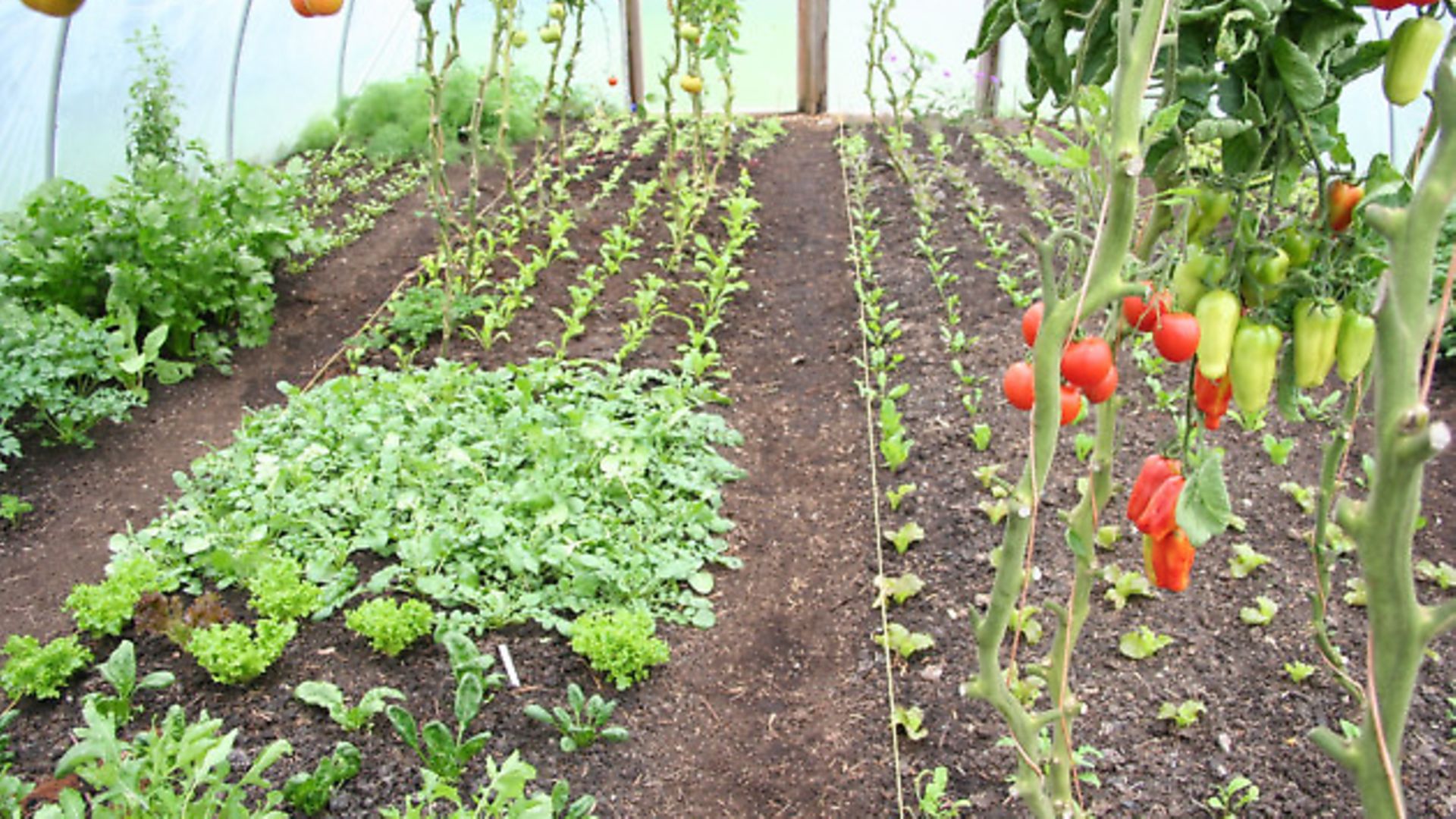Charles shows you how to grow salads undercover for harvests throughout winter and until early May

The advice and dates here are based on growing in polytunnels or a greenhouse. For growing outside with a cloche cover, or in a cold frame, sow two weeks earlier.
However much you may be feeling, at the end of summer, that harvests are the main priority, there is one more batch of sowing and planting to make, mostly in September. You can make these sowings in modules, to have plants ready by the middle of October, just when you are removing tomatoes and other summer vegetables from tunnels and greenhouses. October plantings can then be cropped for six whole months.
Careful picking for continuous cropping
Careful picking of outer leaves, never using a knife, keeps the same plants producing from November until April or May. September sowings use existing warmth in the soil to establish quickly and develop a strong root system before winter. This root system can then power new leaf growth in any milder weather, and gives you bountiful growth in March and April.
In 2013/14, boosted by the mild weather throughout, my salad plants never stopped growing and, from an 18ft x 30ft tunnel, we picked £2,000 worth of leaves between mid November and early May. Picking takes time and needs practice: you can harvest slightly larger leaves to increase the yield, also remove any yellowing leaves, weeds and slugs while you pick to keep plants clean and pest free.
Sowing dates
As summer turns to autumn, fading light and warmth mean you need to be on the ball to sow at the correct time, as plants cannot catch up if sown too late. The dates in this table have proven the test of time for me and, if you are too busy to do sowings on the different dates in the table, one key time is mid September, and a week or 10 days earlier for cool regions.
Sowing into modules
Sow three or four seeds and thin to the strongest seedling. Fast growing brassicas, especially mustards and mizuna, grow well from having two or three plants in a module, set out together as a clump, to have more, smaller leaves. Usually allow four weeks from sowing to planting.
Direct sowing and slugs
The drawbacks with direct sowing are that you can’t do it until summer crops are cleared, and that slugs are hungry in autumn and can easily devour hundreds of seedlings. A foray at dusk with a torch and a knife can solve many problems: check especially the edges of tunnels and frames. I find that thorough slug hunting in September, and infrequent watering once soil is fully moist by late October, sets up the tunnel for a more slug-free winter, apart from pak choi which always attracts them.
Spacings
For salad leaves, you can plant almost everything at the same spacing of 8-9ins (20-25cm), which gives plants enough food and moisture to keep growing until spring, It also allows enough room for your fingers to keep picking the outer leaves.
You will also need less seeds and plants than when salads are grown closely together. For the larger leaves of kale and spinach, space wider.
Variety tips
Some great flavours and colours come from mustards Red and Green Frills, spinach Medania and Red Cardinal, chervil, coriander, and frizzy endive such as Fine Maraichere.
Many varieties of lettuce can be grown overwinter, for picking throughout or to heart in April. I find that Grenoble Red is always the hardiest and lives for longest compared with cos types. September sowings of Little Gem ran to flower in late April whereas Grenoble Red cropped until late May.
Watering before/during winter for vegetables undercover
This is key and there is such a different rhythm to winter watering. Make a mental switch away from summer’s more frequent watering to ‘as little as you dare’, especially during December to mid February, when even the air is often 100% humid so plants are hardly transpiring, as well as growing only slowly.
Good winter watering is helped by fully moistening soil in autumn, before planting or sowing anything, as soon as summer crops are out. After pulling tomatoes, peppers etc I walk on the dry soil to break up any lumps and smooth it down, then water, then check how moist the soil is, then water again. If you just put lots of water onto dry soil, some of it runs through or away, so a briefer watering to help the soil swell up, followed by two or more waterings, achieves fuller moisture to a deep level. Use a trowel or spade to check, and if a spade is difficult to push in, your soil is probably still dry.
Water after planting and then water either weekly on light soil or fortnightly on heavy soil until the weather turns cold, with plants growing slowly. Last winter I watered once in December and once in January, then weekly from early February when growth was more rapid than usual. I gave 8mm per watering compared with 43mm falling outside! All the water came from two butts, using cans.
It is important to allow the surface to dry out between watering, to reduce weed growth, minimise slug incursions and reduce fungal damage to leaves, especially lettuce, which are dry most of the time. Then give enough water to fully moisten the soil and it is worth checking after watering.
And… ventilate!
No vegetables like stale air and, if in doubt, open a door or window of tunnel and greenhouse. More plants die of mildews caused by slow-moving air (especially in the middle of long tunnels) than of frost and cold. Polytunnel doors with gaps around the edge are good.
Image(s) provided by:
Archant







